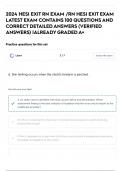Exam (elaborations)
2024 HESI EXIT RN EXAM /RN HESI EXIT EXAM LATEST EXAM CONTAINS 160 QUESTIONS AND CORRECT DETAILED ANSWERS (VERIFIED ANSWERS) |ALREADY GRADED A+
- Course
- Institution
2024 HESI EXIT RN EXAM /RN HESI EXIT EXAM LATEST EXAM CONTAINS 160 QUESTIONS AND CORRECT DETAILED ANSWERS (VERIFIED ANSWERS) |ALREADY GRADED A+
[Show more]



